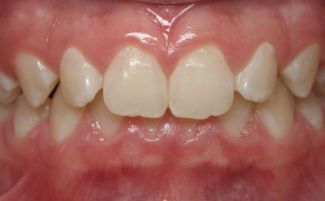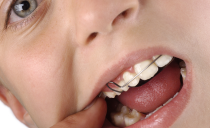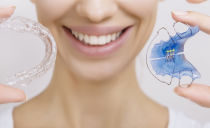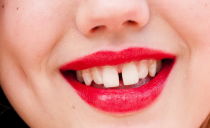Distal (prognathic) bite in adults and children: causes and how to fix
A distal (prognathic) bite is an abnormality in which the teeth of the upper jaw protrude strongly forward. Sometimes pathology is called prognathy. It leads to a number of consequences, most noticeable to others - a change in the proportions of the face. The prognathic bite is well shown in the photo.
Content
Signs of a distal bite
There are several types of prognathy. Symptoms are different, but they have some similarities:
- Convex face. A "bird profile" is formed, in which the chin is shifted closer to the neck, the nose seems larger.
- Loose lip closure. This is due to the fact that the lower lip is shifted back, as a result, the mouth is almost always slightly open.
- Pronounced chin fold. Even after orthodontic treatment, she reminds herself of a deep wrinkle in the chin area.
- Eating problems. People with a distal displacement of the lower jaw are often blamed for inaccurate eating.
- Speech problems. With a certain structure of the bones of the face, a person lisps, and a speech therapist cannot correct this defect.
Types of distal bite
Orthodontists distinguish two types of prognathy, which differ not only in general symptoms, but also in treatment. The main symptom with which the disease is divided into types is the position of the front incisors.
Vertical
Specialists call the vertical bite the distal displacement of the first subclass. With it, the teeth of the upper jaw extend forward and grow towards the lip. They can stick out very much and sometimes even peep through closed lips. The lower jaw is pushed back. Teeth come into contact with the sky and may cause discomfort.
An example of a vertical prognathic bite is shown in the photo:
Horizontal
With a horizontal bite, the upper incisors are facing the oral cavity. They are in the wrong position (slightly in front), so they can damage the gums. Possible consequences, up to the complete death of soft tissues in the injured area.
Horizontal bite can be divided into 2 categories:
- Open.
- Deep.
In patients with an open bite, occlusion (contact) of the teeth of the upper and lower jaw is impaired. A longitudinal gap is formed between them. It greatly affects the pronunciation of sounds and sometimes leads to serious problems in the gastrointestinal tract.
With a deep distal bite, the lower jaw is so moved back that when the mouth is closed, the lower teeth are completely hidden under the upper. Severe gum damage is observed due to the extra load when chewing.
Causes of distal bite
The child adopts from parents not only external signs, but also diseases. According to studies, a distal bite can also be attributed to a number of genetic diseases. True, if preventive measures are observed, such a fate for the child can be avoided.
The main reason for the development of a distal bite in children is bad habits. Prevention of pathology is aimed precisely at eliminating them. These habits are:
- chin support by hand;
- sucking a finger, pens;
- sleep with a pacifier in your mouth.
All these habits lead to the formation of a distal bite in a child, since they have a lasting effect on his teeth and jaw bones. Under their influence, the upper jaw extends forward.
A late weaning also acts as a risk factor. After a year of life, it does more harm than good. Another bad habit can be called breathing through the mouth. It also leads to the development of a distal bite and other dentofacial anomalies, as it prevents the strengthening of bones and chewing muscles.
If it is too late to start injecting solid food into the baby’s diet, his bones and muscles of the face will slowly develop. They just need a load, and when eating soft food it is impossible to get it.
Endogenous diseases and injuries of the maxillofacial region, transferred in childhood, can lead to the formation of a prognathic bite. If the child had to remove the milk tooth, it is necessary to put in its place a removable denture or a special retainer. Otherwise, neighboring teeth tend to fill the void and inhibit the growth of constants. The irresponsible attitude towards milk teeth leads to the fact that in more adulthood you have to think about how to push the lower jaw forward.
Effects
The prognathic bite needs to be corrected, since the consequences of this pathology are very serious:
- Appearance and problems with self-esteem. The distal bite is formed in childhood. It is difficult for a child to avoid ridicule of peers.
- Problems with the temporomandibular joint. The head of the lower jaw with a distal bite is incorrectly located in the articular fossa. It compresses the joints and disrupts the masticatory muscles.
- Gum problems. If the upper jaw protrudes above the lower, the teeth touch the gums, severely damage them and gradually erase.
- Increased tooth abrasion. Chewing load is not distributed correctly. Because of this, the enamel, and then other parts of the tooth are erased. They are more prone to caries, pulpitis, hypersensitivity. In old age, due to pathological abrasion, you can completely lose your teeth.
- Difficulty swallowing and chewing. An incorrect bite affects the state of the stomach, as the teeth do worse with the main function - chewing food. As a result, large loads are placed on the stomach, which ultimately leads to a number of diseases.
- Speech disturbance and facial expressions. Most often, patients with a distal bite are lisped. Their facial expressions are less developed, because they cannot fully utilize the muscles of the lower part of the face.
Correction of a distal bite in children
The distal bite can be corrected with the help of not only braces, but also other orthodontic systems. therefore pathology can be treated at a very young age.
The best results are observed with orthodontic therapy up to 6 years - with a removable bite. At such a young age, the distal bite is corrected even through therapeutic myogymnastics. Its main exercise is the advancement of the lower jaw forward. Thanks to him, bones and joints get used to the correct location, and the masticatory muscles get the necessary load.
Gymnastics is combined with removable plates, which are also used to treat adults. Usually with their help, the effect of a standard orthodontic treatment is fixed.
The plate is a plastic base that repeats the shape of the sky, and an arc of nitinol. The same material is used to make braces. Nitinol has shape memory. The arc evenly presses on the child’s teeth, gradually shifting them in the right direction.
It is better to wear records without removing. But sometimes it’s enough to wear them only at night. The tactics of treatment depend on the complexity of the situation and the age of the patient.
After 13-14 years, the child may have braces.Usually, all molars erupt at this point, so nothing prevents the elimination of the pathology.
Correction of a distal bite in adults
Correcting a distal bite in adulthood is a more difficult task. There are several reasons why the correction of the dentition is difficult with age:
- teeth and jaw bones are already fully formed and therefore unyielding;
- the patient has developed persistent habits associated with improper eating and breathing;
- treatment methods are more complex and have a number of contraindications, among which are common chronic diseases.
The main “tool” used in dentistry to correct the distal bite in adulthood is braces. To reduce the time they are worn, patients are equipped with frame orthodontic appliances. They are practically not visible externally, since they are fixed from the side of the sky. Similar devices are used if the front teeth protrude forward, and are aimed at expanding the jaw and correcting the position of the incisors.
The process of correcting the dentition with the help of braces takes up to 6 months. Moreover, the frame apparatus reduces the total time wearing braces by 8-12 months.
At the end of the first stage of treatment with the use of a fixative, the patient can install braces. They will help to achieve the desired result and extend the jaw to the right place.
If you need to correct the bite in the shortest possible time, as well as in the presence of serious orthodontic abnormalities, a facial arch is used. It is an apparatus that fixes the position of the jaw. You need to wear the design for only 2-3 hours a day.
In the presence of serious abnormalities in the structure of the dentition, surgical intervention may be required. During the operation, the bones of the jaw are exposed. The surgeon divides them into 2 fragments, and then connects them in the correct way. The patient spends in a hospital for about a week.
Prevention of dentition
Distal displacement of the lower jaw is formed in childhood, therefore, parents should carry out prophylaxis. To protect the child from such an ailment, follow these recommendations:
- Take milk teeth as seriously as they treat molars. Take your child to dentistry in a timely manner, pay due attention to oral hygiene.
- Do not start respiratory diseases. They need to be treated at the initial stage.
- At the appropriate age, include solid foods in your child’s diet. Gradually increase its amount.
- Wean the baby from the nipple in a year and a half (it is possible earlier). It is necessary to wean the baby from the sucking reflex, and not to replace one bad habit with another.
- Make sure that the child does not rest the collections hand in hand and do not gnaw on foreign objects.
Distal bite is a childhood disease that brings a lot of problems in adulthood. Do not let the pathology drift, since the consequences can affect not only the teeth and jaw, but also the health of internal organs. It takes longer to treat a distal bite in adults, so it’s best to start it as soon as possible.



